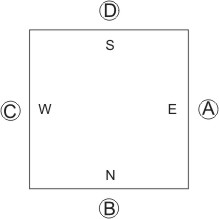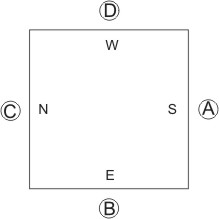The complete game of Mah Jong ordinarily consists of 16 hands (or deals), though the number may be increased each time the dealer (East) wins, or when a deal ends in a draw. Each hand begins with the building of the Wall, breaking it, and dealing the tiles.
Before the game starts players throw the dice several times in order to determine the seat order, the first dealer (East) and to determine the place where the Wall is to be broken.
First the four players take temporary seats arbitrarily. Any of them throws two dice and beginning with himself as one, counts counterclockwise to the number shown by the dice. The player so indicated becomes "temporary East", and the other three seats, in counterclockwise order, temporary South, West and North.
Next any player mixes four wind tiles, one of each wind, face down on the table and arranges them in a stack.
Temporary East then throws the two dice and counts counterclockwise, starting with himself. The player indicated by the dice then picks up the topmost wind tile. The other three players, in counterclockwise order, pick up the next tiles from the stack. Each player then assumes the seat indicated by the tile which he has drawn; the seat locations are determined in stage one (for details, see Fig. 1).
The player who is now temporary East then throws the two dice and counts counterclockwise, starting with himself. The player indicated by the dice will become the final East for the first deal of the game. The other players are assigned winds accordingly in counterclockwise order.
Note. There are significant variations related to preliminaries of the game. Some players simply stack up four wind tiles in random order, after which dice is thrown to determine who picks up the uppermost tile, each player in counterclockwise order picking up the next tile from the stack. The player who gets the East wind remains seated, the player who gets the South wind will sit on his right, etc.
The players retain their relative positions (though not their seat designations, as the winds rotate) until the game has been completed.

a) Any player (here A) throws the dice. Here A throws seven, so C becomes the "temporary East". |

b) The other players take temporary seats in counterclockwise order. (Note the difference to compass winds.) This determines the final location of seats. |
|
|
|

d) Temporary East throws the two dice – four in this case – and counts counterclockwise, starting with himself. |
|
f) The other three players, in counterclockwise order, pick up the next tiles from the stack. Each player then assumes the seat indicated by the tile which he has drawn, i.e., player C picks up the second tile (in this case West), player D picks up the third tile (South) and A picks up the fourth tile (East). |
|

g) Each player then assumes the seat indicated by the tile which he has drawn, the seat locations being determined in stage B. Note that the winds follow each other in counterclockwise direction in order East, South, West and North (the order in which winds are customarily listed in Chinese) so they do not follow compass directions. Player A is now temporary East. |

h) Temporary East (player A) throws the two dice – four in this case – and counts counterclockwise, starting with himself. |

i) The player thus indicated becomes the final East, and the other players are assigned the winds accordingly in counterclockwise order. |
|
Before each hand all the tiles are placed face down on the table and thoroughly mixed by non-dealers, until East gives the command 'Pow' (meaning 'start'), after which each of the four players picks up 34 tiles and builds a row of tiles in front of him, 17 tiles long and 2 high (if Flowers and Seasons are used, 36 tiles are picked, forming a 18 tiles long row; if only Flowers are used, East and West build a 18-tile long row and South and North build a 17-tile long row). Each player then pushes his row forward to form a hollow square. This formation is called Wall.
To determine the breaking point of the Wall, the dealer (East) throws the two dice and counts counterclockwise round the walls, beginning with himself as one (accordingly, numbers 5 and 9 indicate East, numbers 2, 6 and 10 South, numbers 3, 7 and 11 West and numbers 4, 8 and 12 North). East then counts off along the tiles of the top tier of the wall indicated by the dice (a stack of two tiles at a time), starting from the right end. E.g., if he throws 6, he will count 6 stacks from the right end of the South's wall.
Note: Some players use a rule according to which East of the very first deal does not throw dice to determine the breaking point of the Wall but instead breaks his own Wall at the point indicated by the last throw of dice (e.g., in the example above four was thrown).
East makes a break in the wall by pushing slightly the tiles to the left of the breaking point.
The eight stacks of tiles to the right of the breaking point are known as Dead Wall (or Kong box); the remaining tiles, starting from the tiles to the left of the breaking point, constitute the live Wall. The 16 tiles of the Dead Wall are reserved as replacement tiles for Kongs (and Flowers and Seasons, if they are used). The Dead Wall is replenishing so the used supplement tiles are replaced by reserving new tiles from the tail end of the live Wall (however, the supplement tiles are always taken from the left end of the Dead Wall).
East starts the deal by taking the first two stacks of the tiles (i.e., four tiles) from the left of the break, then each of the other three players pick two stacks of tiles in order South, West and North. This is repeated three times so that each player has 16 tiles. East then draws one additional tile. Thus the dealer has 17 tiles and the other three players each 16 tiles.
The hand starts by each player arranging the dealt tiles so that their faces are not visible to the opponents, but in such a way that the other players may count them.
If Flowers and Seasons are used, and the dealt hand contains Flowers or Seasons, they are immediately melded (placed face up above and to the side of the hand) and replaced with regular tiles taken from the Dead Wall (East replaces first his extra tiles, then South, West and North). Should a player draw further bonus tiles during this replacement procedure, he must wait until the other players have drawn their supplement tiles before replacing further tiles.
|
|

b) East throws the two dice – eight, in this case – and counts counterclockwise round the walls. |

c) East then counts off 8 stacks (the number indicated by the last cast of the dice) along the tiles of the top tier of the wall of the player indicated in stage B (North's wall in this case), starting from the right end, and breaks the wall. The 16 tiles to the right of the breaking point (gray tiles in the picture) constitute the Dead Wall. |
|
| d) The players take each 2 stacks of tiles (i.e., four tiles at a time) from the start of the live Wall, in order East, South, West and North, until each player has 16 tiles. East then picks one tile more to have 17 tiles in hand. | |
Related topics:
Introduction
Tiles
Playing
Miscellaneous
Scoring
Payments